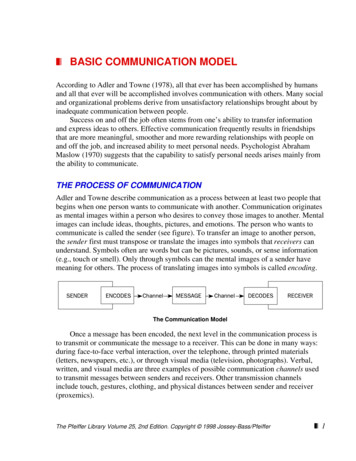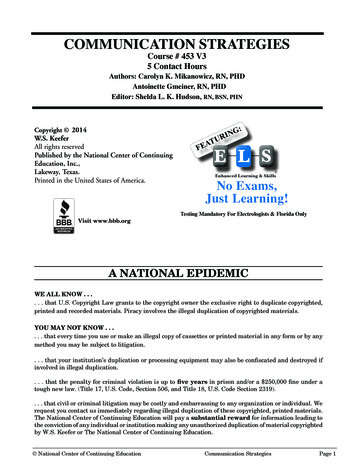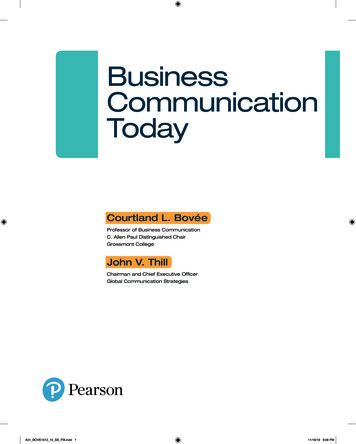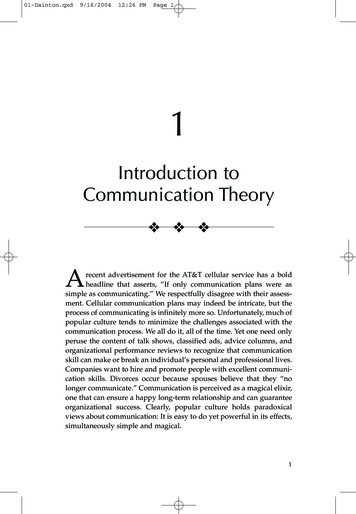
Transcription
BASIC COMMUNICATION MODELAccording to Adler and Towne (1978), all that ever has been accomplished by humansand all that ever will be accomplished involves communication with others. Many socialand organizational problems derive from unsatisfactory relationships brought about byinadequate communication between people.Success on and off the job often stems from one’s ability to transfer informationand express ideas to others. Effective communication frequently results in friendshipsthat are more meaningful, smoother and more rewarding relationships with people onand off the job, and increased ability to meet personal needs. Psychologist AbrahamMaslow (1970) suggests that the capability to satisfy personal needs arises mainly fromthe ability to communicate.THE PROCESS OF COMMUNICATIONAdler and Towne describe communication as a process between at least two people thatbegins when one person wants to communicate with another. Communication originatesas mental images within a person who desires to convey those images to another. Mentalimages can include ideas, thoughts, pictures, and emotions. The person who wants tocommunicate is called the sender (see figure). To transfer an image to another person,the sender first must transpose or translate the images into symbols that receivers canunderstand. Symbols often are words but can be pictures, sounds, or sense information(e.g., touch or smell). Only through symbols can the mental images of a sender havemeaning for others. The process of translating images into symbols is called encoding.The Communication ModelOnce a message has been encoded, the next level in the communication process isto transmit or communicate the message to a receiver. This can be done in many ways:during face-to-face verbal interaction, over the telephone, through printed materials(letters, newspapers, etc.), or through visual media (television, photographs). Verbal,written, and visual media are three examples of possible communication channels usedto transmit messages between senders and receivers. Other transmission channelsinclude touch, gestures, clothing, and physical distances between sender and receiver(proxemics).The Pfeiffer Library Volume 25, 2nd Edition. Copyright 1998 Jossey-Bass/Pfeiffer 1
When a message is received by another person, a decoding process occurs. Just as asender must encode messages in preparation for transmission through communicationchannels, receivers must sense and interpret the symbols and then decode theinformation back into images, emotions, and thoughts that make sense to them. Whenmessages are decoded exactly as the sender has intended, the images of the sender andthe images of the receiver match, and effective communication occurs.HOW COMMUNICATION BREAKS DOWNIf everyone were to have the same experiences, all messages would be encoded,transmitted, and decoded alike. Symbols would have the same meanings for everyone,and all communication would be received as the senders intended. However, peoplediffer in their personal histories, ways in which they experience things, and emotionalresponses, leading to differences in the ways in which communications are encoded,transmitted, received, and understood. Different people attach different meanings to thewords, pictures, sounds, and gestures used during communication.Difficulty with the encoding and decoding of images is not the only factor thataffects the effectiveness of communication between people. Adler and Towne use theconcept of noise to describe physical and psychological forces that can disruptcommunication.Physical noise refers to conspicuous distractions in the environment that make itdifficult to hear or pay attention. For example, when the environment is excessively hotor excessively cold, or when one is in a noisy nightclub, one may tend to focus moreconcern on the situation than on the message. Physical noise can inhibit communicationat any point in the process—in the sender, in the message, in the channel, or in thereceiver.Psychological noise alludes to mechanisms within individuals that restrict asender’s or receiver’s ability to express and/or understand messages clearly. Forexample, senders with limited vocabularies may have difficulty translating images intosymbols that can be understood easily by receivers. Receivers with inflated selfconcepts may filter messages that disagree with their self-perceptions and put energyinto defending themselves rather than into understanding the messages. Psychologicalnoise most often results in defensiveness that blocks the flow of communicationbetween sender and receiver.With the many ways in which communications can be encoded, channeled, anddecoded, there is little wonder why so many difficulties exist when people attempt tocommunicate with one another. Yet communication processes become more complex.Discussing communication in terms of sender-receiver implies one-way communication.However, human communication often is a two-way process in which each party sharessending and receiving responsibilities. As the quantity of people taking part in acommunication increases, the potential for errors in encoding and decoding increases,along with the potential for physical and psychological noise.2 The Pfeiffer Library Volume 25, 2nd Edition. Copyright 1998 Jossey-Bass/Pfeiffer
REFERENCESAdler, R., & Towne, N. (1978). Looking out/looking in (2nd ed.). New York: Holt, Rinehart and Winston.Maslow, A. (1970). Motivation and personality. New York: Harper & Row.The Pfeiffer Library Volume 25, 2nd Edition. Copyright 1998 Jossey-Bass/Pfeiffer 3
The Communication Model
CONVERGENCE STRATEGIESWalt Boshear and Karl Albrecht developed the convergence-strategies model to dealwith the concept of motion in relationships between people. It leads to deliberatestrategies for establishing, maintaining, and improving relationships.STABLE, CONVERGING, OR DIVERGING RELATIONSHIPSThe model categorizes all relationships as stable, converging, or diverging. In a stablerelationship, two persons have reached a conscious or unconscious agreement regardingthe ways in which they will relate to each other. They avoid any behavior that willchange the relationship. On the other hand, relationships that are in a state of change canbe either converging or diverging. A converging relationship is changing in ways thatenhance the benefits of the relationship to the participants. A diverging relationship ischanging in ways that tend to destroy the relationship or detract from its benefits to theparticipants.Personal Versus Impersonal RelationshipsAny of the three types of relationships can be predominantly personal or predominantlyimpersonal. At the personal extreme, the ego-involvement of the participants—theirattitudes, beliefs, and feelings—are an integral part of the relationship. On the otherhand, emotional and personal issues are not considered in the impersonal relationshipand generally will be disruptive to it if they arise.A premise of the model is that forces, such as the consequences of growing up andthe mores of Western culture, push individuals in the direction of impersonal, stablerelationships. From birth through adolescence, individuals are cast in roles ofdependency and inadequacy. They are surrounded by people who, by virtue of their ageand experience, are better able to cope with their environment and who have been placedin positions of authority by cultural tradition. In Western culture, individuals are taughtto control their emotions and follow the traditions of society. They are stronglyencouraged to refrain from making any emotional attachments except those that areapproved by society, such as courtship, marriage, and a few close friendships.In addition to the forces of culture that guide the individual in establishing andmaintaining relationships with people, there are the forces of time and exposure. Thehuman intellectual and emotional system is highly adaptive and it tends toward stability.Experiences that initially may provoke a strong intellectual or emotional response will,when sustained or repeated, tend to elicit a lesser response.The figure diagrams the structure of the model and the relationships between itselements. The internal arrows indicate the natural course of relationships under theThe Pfeiffer Library Volume 25, 2nd Edition. Copyright 1998 Jossey-Bass/Pfeiffer 5
influence of time, exposure, and cultural forces. A relationship that originates with orpresently has the characteristics described in any of the squares in the diagram tends toprogress in the direction shown by the arrows. However, this progress is contingent onthe absence of deliberate strategies by the participants or disruptive events outside istenceCreativityandInnovationThe Impact of Cultural Forces on RelationshipsStable relationships tend to remain stable, but will, through time, incline towardrepetitive behaviors and coexistence of the participants. Probably the most typicalexample is the course of many courtships and marriages. Initially a man and womandevelop a highly personal, caring relationship. As they spend more time together, therelationship converges, and the personal stake that each feels in the relationshipincreases. At the point of marriage and during the early honeymoon phase, they are atthe peak of a high-intensity, interdependent phase. As time goes by and each becomesmore familiar with the other, the relationship stabilizes as a warm, personal marriage ofsharing and cooperation. If the marriage partners are not innovative in keeping theirrelationship on a personal basis, it gradually becomes more and more impersonal until,in many cases, they can be said only to be sharing the same residence. They reach ahighly repetitive, impersonal, coexistent phase that may go on indefinitely unless it isdisrupted and goes into competition, withdrawal or combat. Then the relationship tendsto restabilize at the same or lower level of personal commitment or deteriorate throughcompetition or withdrawal.If the individuals in a relationship want to increase their personal involvement, theymust learn and apply deliberate strategies to cause converging to happen and to maintainthe new relationship. Suggested by the model, the following are some applicablestrategies.Awareness of process. Individuals who are involved in a relationship should beaware of the process of that relationship. This requires them to learn about relationshipsin general and acquire a conceptual framework and vocabulary for monitoring theprogress of their own relationship.6 The Pfeiffer Library Volume 25, 2nd Edition. Copyright 1998 Jossey-Bass/Pfeiffer
Allocation of time. Whether or not the relationship involves a task (e.g., problem,sport, hobby), at least some time should be devoted to maintaining the relationship andmeeting the individual needs of the participants. Although those needs may not directlybe a part of the relationship, they must be dealt with in order for the individuals tocontinue in the relationship.Communication skills. On one hand, verbal language provides more opportunitiesfor misunderstanding than for understanding, and on the other hand, many things thatare vitally important to a relationship cannot be verbalized at all. Consequently, peopleshould develop their skills in both verbal and nonverbal communication about a widerange of subjects that may be relevant to the relationship, such as emotions, feelings,thoughts, ideas, beliefs, suspicions, fears, and apprehensions.Options for behaving and feeling. Any extended relationship between peopleplaces numerous demands on their behavior and feelings. In order to respond to thesesituations in ways that are appropriate and beneficial to the relationship, the participantsneed to develop a range of options for behavior and feelings. For example, person Aestablishes a normal pattern of being understanding whenever person B takes advantageof their friendship. Repetition of that behavior can establish such strong reinforcementthat A may feel that he or she has lost the option to become angry about it. The reversemay also be true: an established pattern of anger may lead to the loss of the option to beunderstanding.Willingness to risk. Disturbing a “safe” and “satisfactory” relationship can lead toimproving the benefits of the relationship for the participants, but it requires theirwillingness to take emotional risks. They must be willing and able to trust each otherand to expose themselves to anger, fear, joy, and even rejection as a “down payment” ondeeper understanding and more rewarding relationships.USE OF THE MODELThe concept of convergence strategies can lead to structured or unstructured experiencesthat can be used in counseling and training sessions to enable individuals to learn andpractice the skills and strategies for counteracting the forces of time, exposure, andculture. Many examples can be found to demonstrate the inferences and operation of themodel. Presented early in a learning session, the model can serve as a frequent referencepoint to evoke an understanding of the ongoing processes and the reason for learningsuch skills. Because the model focuses directly on the cultural forces that will act onindividuals as they leave the isolation of the learning environment, it can be used toprepare individuals for the re-entry process. It provides a conceptual framework forexamining the probable consequences of these cultural forces and the options that areavailable to counteract them.The model is slightly more complex than many, requiring longer to develop andexplore. Frequently, clarifying the concepts and exploring relevant examples lengthenThe Pfeiffer Library Volume 25, 2nd Edition. Copyright 1998 Jossey-Bass/Pfeiffer 7
the presentation and discussion. This extended focus on the model can distract groupmembers from a “here-and-now” orientation.SourceBoshear, W.C., & Albrecht, K.G. (1977). Understanding people: Models and concepts. San Diego, CA: Pfeiffer &Company.8 The Pfeiffer Library Volume 25, 2nd Edition. Copyright 1998 Jossey-Bass/Pfeiffer
yandInnovationThe Impact of Cultural Forces on Relationships
EFFECTIVE NEGOTIATIONLife includes abundant opportunities and reasons to negotiate. Whether the subject issalary, who walks the dog, or the size of nuclear arsenals, negotiation usually is theprocess by which we make decisions and allocate resources. Despite its importance inevery aspect of existence, most of us know very little about the art of negotiation. Formost people, successful negotiation is splitting the difference. For example, Jane mightsay that she wants 185 for her old skis, Stan might say that he will pay 150, and theyagree on a price of 167.50.Roger Fisher, William Ury, and their colleagues at the Harvard Negotiation Projecthave studied negotiation systematically. In their book, Getting to Yes: NegotiatingAgreement Without Giving In, Fisher and Ury (1981) criticize “splitting the difference”as an unimaginative and often unsatisfactory compromise in a nonprincipled negotiation.They also describe how to negotiate effectively.PRINCIPLED VERSUS POSITIONAL BARGAININGAccording to Fisher and Ury, the most common mistake that negotiators make is tobargain over positions rather than principles. When Jane says that she will not sell herused skis for less than 185, and Stan says that he will not pay more than 150, the twoparties are locked into positions from which neither can retreat gracefully. What is more,both the buyer’s and the seller’s positions seem to be somewhat arbitrary; thenegotiation lacks any principled basis for determining a fair market value for the skis.One possible outcome is that positional bargaining will cause negotiations to breakdown, perhaps because offering an intermediate price is an admission that previousstatements were untruthful. On the other hand, the parties may split the difference,enabling them to reach agreement. However, that form of compromise often produceswhat Fisher and Ury call “an unwise agreement”—one that fails to serve the underlyinginterests of either party. Jane will not get the full 185 she wanted in order to pay off thebalance on her credit-card bill, and Stan will spend more than he budgeted for the usedskis.Hard and Soft NegotiationFisher and Ury believe that positional bargaining only permits the negotiator to adoptone of two stances. The negotiator can play the game softly, or the negotiator can playthe game hard. For instance, if the seller lowers her price to 150, then she may havecaved in to the buyer’s hard pressure. Likewise, the buyer might dislike haggling overmoney because it makes him nervous, and he might meet the seller’s demand byadopting a soft stance in the negotiation.10 The Pfeiffer Library Volume 25, 2nd Edition. Copyright 1998 Jossey-Bass/Pfeiffer
The soft negotiator places a higher value on the feelings and relationships of thebargainers than on the substance of the transaction. Hence, soft negotiators will give inon crucial points to promote good feelings, will retreat from their positions, will acceptoutcomes unfair to themselves in order to facilitate a deal, and will avoid conflict at allcosts. If the soft negotiator’s bargaining partner has adopted a hard posture, the softnegotiator is likely to be exploited. On the other hand, if a soft negotiator’s adversaryalso has adopted a soft stance, the two may compete to accommodate each other in anegotiation whose sloppy outcome might be damaging to both parties. The example thatFisher and Ury give of the damage that can occur when two softies get together is O.Henry’s story, The Gift of The Magi, in which the husband sold his watch to buy combsfor his beloved wife’s hair, while she sold her hair to buy an elegant watch chain forhim.Hard negotiation places greater value on the issues or things in the transaction thanon the relationships of the bargainers. Hard negotiators will require their negotiationpartners to give ground as a price for maintaining the relationship, will hold tenaciouslyto their positions, will exact unfair outcomes in return for arriving at agreements, andwill attempt to win battles of wills.Principled NegotiationPrincipled negotiation transcends the contest over positions that typifies both hard andsoft approaches to negotiation. Instead of deciding whether to play a “hard” or “soft”game, principled negotiators negotiate on the basis of merit. Fisher & Ury (1981, p. 13)observe that: Soft negotiators are soft on the people and the problem. Hard negotiators are hard on the problem and the people. Principled negotiators are soft on the people, hard on the problem.THE FOUR STRATEGIES OF PRINCIPLED NEGOTIATIONThe members of the Harvard Negotiation Project conclude that principled negotiation ismore likely to produce wise agreements than is positional negotiation. The middle panelin the large table lists the four main strategies of a principled negotiator, and the sidepanels summarize the corresponding strategies of soft and hard negotiators.Strategy One: Issues, Not PersonalitiesIn any negotiation, the parties have an interest both in the substance of the matter and inthe relationships between themselves. Positional bargaining swaps the interest in therelationship for the interest in the substance; principled negotiation attempts to preserveboth interests by separating the personality questions from the substantive interests.This can be done as follows:The Pfeiffer Library Volume 25, 2nd Edition. Copyright 1998 Jossey-Bass/Pfeiffer 11
Three Approaches to Negotiation1. Recognize the legitimacy of differences in perception. Understanding the otherside’s point of view is not a hazard to be avoided in the process of negotiation; itis the main benefit of accurate and clear communication and it makes creativeagreements possible.2. Structure proposals so that the other side can go along with them without “losingface.”3. Accept and deal with the emotions of both sides in the negotiation. Permit thepeople on the other side to express their emotions, and adopt the rule “only oneperson can get angry at a time.” That way it is legitimate for both sides to relievepressure, but the negotiation will not end in uproar and mutual recrimination.4. During negotiations, use techniques of effective communication, such as activelistening, speaking to be comprehended, and using I-messages rather thanaccusatory you-messages.5. Work to prevent the deterioration of the relationship. Structure the negotiation sothat the parties jointly confront the problem instead of each other. Rather thansquaring off on opposite sides of the bargaining table, it helps to sit at the sameside of the table, jointly facing the relevant documents.Strategy Two: Breaking Out of the Position TrapIn the negotiation over the second-hand skis, although Stan had previously stated that hewould not pay more than 150 for Jane’s skis, his real interest was to stick to his budget.Jane’s position was that she would take no less than 185 for the skis, although her real12 The Pfeiffer Library Volume 25, 2nd Edition. Copyright 1998 Jossey-Bass/Pfeiffer
Give in on crucialpoints to promotegood feelingsDeal with issues ofthe negotiation notthe personalitiesRequire others togive ground as priceto maintain therelationshipRetreat frompositionsBreak out of theposition trapHold tenaciously topositionsAccept unfair outcomes in order topermit arriving ata dealSeek win-winoutcomesExact unfairoutcomes as pricefor arriving at a dealAvoid conflict atall costsTry to base negotiation outcomes onobjective standardsAttempt to win acontest of resolveSOFTPRINCIPLEDEffective NegotiationHARD
interest was to raise sufficient cash to pay off her credit-card bill. Both are in theposition trap.Fisher and Ury suggest breaking out of the position trap by identifying interests.There are at least four ways in which to identify interests in a negotiation:1. The most obvious way to identify interests is for negotiating partners topersistently ask each other why they have adopted particular positions or resistedtheir negotiating partner’s positions. The answer almost always will be that aninterest is served by the position or thwarted by the other side’s position.2. Talk directly about interests.3. As interests are exposed, write them down. Keep a list.4. Treat the other side’s interests as legitimate, at least for them.Fisher and Ury also remind us that although it is not a good idea to commit oneselfto one’s position, it is necessary to commit to one’s interests.This is the place in a negotiation to spend your aggressive energies . . . . Often the wisest solutions,those that produce the maximum gain for you at the minimum cost to the other side, are producedonly by strongly advocating your interests. Two negotiators, each pushing hard for their interests,will often stimulate each other’s creativity in thinking up mutually advantageous solutions. (pp.56-57)Strategy Three: Creatively Seeking WIN-WIN OutcomesOne of the reasons why many people dread negotiations is that most of their experienceinvolves positional bargaining, which often produces losers and winners. Positionalbargaining is a win-lose game, and nobody wants to be the one who loses. Frustratingdeadlocks or mechanical splits of the difference also occur. In almost every case, thepositional bargaining process feels stressfully competitive, sometimes frustrating evenfor those who did not actually experience defeat. It takes some creativity to generate thewin-win outcomes called for by principled negotiation. However, if the underlyinginterests of both parties have been identified, it becomes possible to invent agreementsthat will satisfy the interests of both parties.For instance, recognition of Jane’s underlying interest in paying off her credit-cardbill and Stan’s interest in budget discipline suggests a creative alternative in which bothparties are winners. Jane apparently values paying off the bill more than possessing skiequipment. Stan, who values adherence to his budget, will not be able to ski unless healso has obtained ski poles, gloves, boots, and other equipment. If Stan is willing topurchase some more equipment from Jane, she may obtain the money she needs to payoff her credit-card bill, and Stan might be able to stick to his budget for the skis while hebuys other equipment at or near the price he has budgeted for it.14 The Pfeiffer Library Volume 25, 2nd Edition. Copyright 1998 Jossey-Bass/Pfeiffer
Strategy Four: Objective StandardsPrincipled negotiation seeks standards outside the will of the negotiators fordetermination of a fair and wise agreement. If Stan decides to buy Jane’s ski poles aswell as her skis, the interests of the two parties—his budget and her financialrequirements—might determine the prices. Alternatively, and more fairly, the pricescould be determined by an objective standard, such as a catalog of second-hand pricesprepared by a skiing publication, an average of prices in local classified advertisements,or the prices charged by a nearby second-hand store. It may be that the skis are worth asmuch or more than Jane first demanded, in which case she should consider findinganother buyer or Stan should consider revising his budget. If the objective price comesout lower than Jane’s original position, she may need to consider meeting her interestsby selling more equipment. Alternatively, she may need to revise her goal of paying offthe credit-card bill this month or in this way.A TACTIC FOR THE UNDERDOGMuch of the preceding discussion may seem to imply that principled negotiation takesplace between equally powerful negotiating partners. However, that is not always thecase. Fisher and Ury say that a skillful negotiator always should be aware of his or her“BATNA—Best Alternative to a Negotiated Agreement.” A negotiator who knows whathis or her alternatives are is less desperate to reach agreement and less likely to bepressured into accepting “an offer that can’t be refused,” even though he or she is theunderdog.Assuming that Jane is the underdog, because she needs the money more desperatelythan Stan needs the skis, she will be under substantial pressure to accede to his pricedemands. However, if she knows that borrowing the money she needs from a friend isher BATNA, at some point she could break off the negotiation with Stan, rather thanagree to an unfair price.GETTING THE OTHER SIDE TO PLAY BY THE SAME RULESPositional bargaining is seductive. If “A” enters a negotiation with the best intents toconduct principled bargaining, the other party, “B,” might criticize A’s principledproposal and dig in behind a position. This might lead A to defend the proposal andmake it a position from which he or she cannot easily retreat.In order to avoid the seduction of potentially fruitless, positional bargaining, Fisherand Ury recommend the following:1. Probe beneath the other side’s position to identify the underlying principles.2. Allow the people on the other side to ventilate their emotions. Recast theirpersonal attacks as attacks on the predicament in which both parties findthemselves.The Pfeiffer Library Volume 25, 2nd Edition. Copyright 1998 Jossey-Bass/Pfeiffer 15
3. Put proposals in the form of questions to which the other side can respond withinformation rather than in the form of assertions. (The other side is likely torespond to assertions with rejections and intractable position statements.)4. Respond to the other side’s positional assertions with silence. (The silenttreatment will provoke more statements and possibly some reasonableproposals.)To get both sides to play by the rules, Fisher and Ury also suggest the use of a thirdparty intervention method called the “one-text procedure.” In the one-text procedure, theintervenor listens to both sides and presents a written proposal based on the statementsof the two sides. Each side submits its criticism of the proposal, and the intervenor thenrevises the text of the proposal and resubmits it to the two sides. This process is repeateduntil the negotiation fails or—more optimistically—the intervenor has produced a text towhich each side can give its assent. According to Fisher and Ury, in 1978, the UnitedStates performed the intervenor role in a one-text negotiation that resulted in the CampDavid Accords between Israel and Egypt.OVERCOMING SKULDUGGERYNot everybody plays fair or negotiates in good faith. Fisher and Ury recommend ways tocounteract several typical, bad-faith negotiating tactics.DeceitSome negotiators might attempt to defraud their adversaries or might conceal ormisrepresent their lack of authority to conclude an agreement. Without calling the otherside liars, express doubts or seek verifications. If they really mean to live up to theiragreement, they ought not to object to putting it in writing and providing materialsafeguards against the contingency that they default on the deal. If one must negotiatewith particular people, it is not unfair to insist on knowing what their bargainingauthority is. Deception regarding authority could unfairly give the other side “a secondbite at the apple.” It could reach an agreement, claim the lack of authority toconsummate it, and then seek further concessions.Head GamesSome people will attempt to use psychological ploys to confuse, intimidate, or deceivetheir adversaries. Recognizing the ploys is half the solution; sometimes explicitlyconfronting them is the other half. For instance, if it seems that one deliberately has beenseated so that the sun will be in one’s eyes, it is legitimate to say, “I might be wrong, but
Discussing communication in terms of sender-receiver implies one-way communication. However, human communication often is a two-way process in which each party shares sending and receiving responsibilities. As the quantity of people taking part in a communication increases, the










